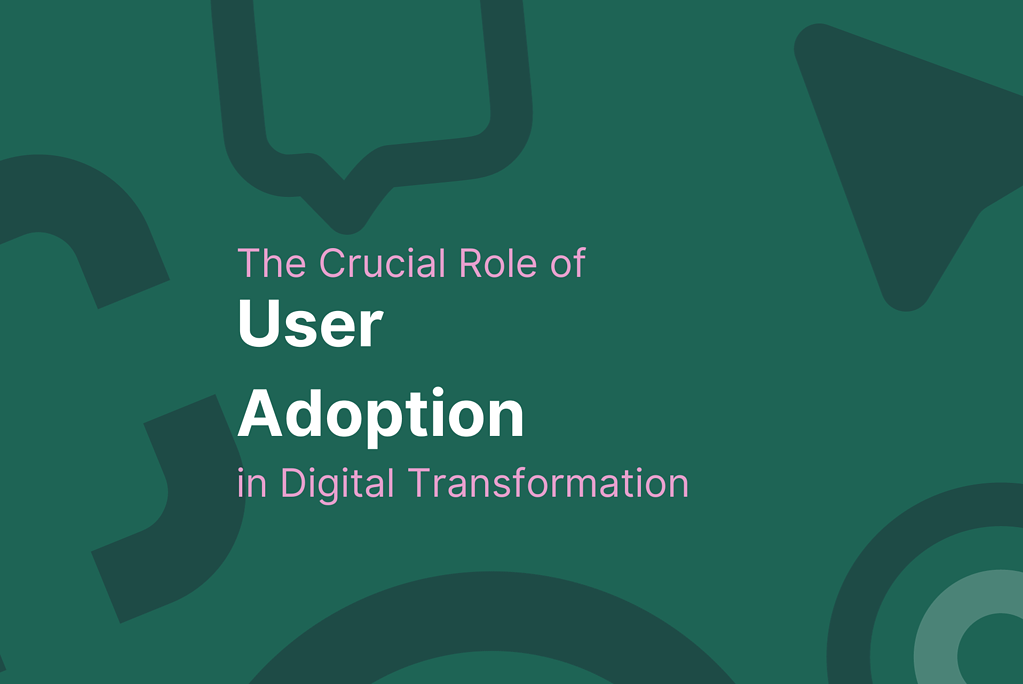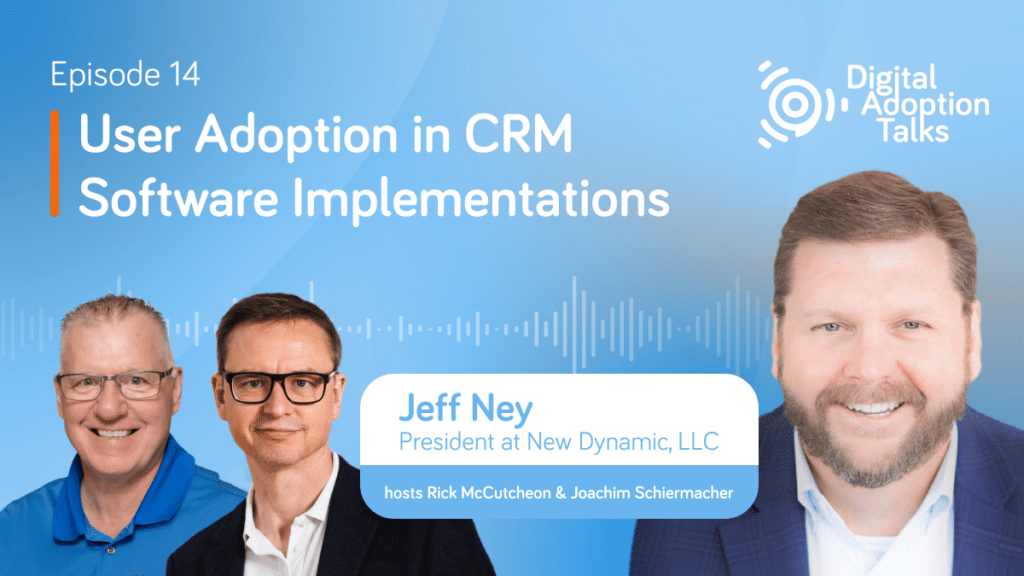Digital Adoption Talks: A deep dive into user adoption
Digital Adoption Talks is a renowned podcast series that delves into the intricacies of digital adoption, offering listeners invaluable insights from industry experts. In episode 14, Jeff Ney, president of New Dynamic, shares his profound understanding of the CRM landscape and the pivotal role of user adoption in ensuring the success of digital transformation efforts.
The importance of user adoption in digital transformation
Digital transformation is about leveraging digital tools to improve business processes, culture, and customer experiences. However, even the most advanced software solutions can fall flat without widespread digital adoption. Ney himself notes that the CRM landscape, in fact, hinges on user adoption. For instance, a company might implement a state-of-the-art CRM system, but if the sales team doesn’t embrace it, the technology investments become futile.
The digital era has ushered in various new software and digital processes designed to optimize operations and enhance user engagement. Yet, the success of these tools is not just about their capabilities but how they are adopted and integrated into daily workflows. As Ney highlights, infrequent tasks or tasks perceived as complex can become barriers to adoption. This is where digital adoption platforms (DAPs) come into play, offering in-app guidance and continuous training to ensure users navigate the system efficiently.
Moreover, the business outcomes of digital transformation are directly tied to user adoption. Often, projects with excellent user adoption show increases in shareholder returns and overall revenue. In contrast, projects with poor adoption often end up not just costing a fair amount, but end up generating next to no measurable changes to the bottom line. This underscores the financial implications of user adoption in digital transformation projects.
The digital adoption vs. digital transformation debate is not about choosing one over the other. It’s about understanding that digital transformation is the vehicle, while adoption is the fuel. Without users adopting new technologies, the journey stalls.
Business leaders must recognize that user satisfaction, ease of use, and personalized training are all paramount for software adoption efforts to succeed. As Ney aptly put it, it’s not just about introducing new digital tools but ensuring that “every day is not changed.” If there are changes, they should be communicated effectively, ensuring that the workforce understands the benefits and is equipped to adapt.

Efficient training and good change management help organizations strive toward effective user adoption in their digital transformation initiatives.
Challenges in achieving high user adoption
Digital transformation revolves around harnessing digital tools to enhance business processes, culture, and customer experiences. Yet, even the most sophisticated software solutions can underperform without robust digital adoption. Ney’s insights underscore this, emphasizing that success in the CRM landscape is deeply tied to user adoption. Imagine a scenario where a company rolls out a cutting-edge CRM system, but the sales team remains aloof. Such reluctance can render the technology investments ineffective.
Some of the most common challenges that can hinder your digital adoption rate include:
- Resistance to change: Employees, especially those accustomed to traditional methods, might resist new digital tools. Regularly communicate the benefits and value of the new system to all users to improve user onboarding and your digital transformation success overall.
- Lack of proper training: Without adequate training, users might find new systems complex and intimidating. Offer customized training sessions that cater to different user groups and learning styles.
- Perceived lack of value: If the benefits of the new system aren’t clear, users might question its value. Highlight success stories and positive outcomes resulting from successful digital adoption to ensure end users understand the total value of new software.
- Technical issues: Glitches or bugs can deter users from fully adopting a new system. Ensure a responsive technical support team to address issues swiftly, so that bugs won’t discourage employees and delay user productivity.
- Overwhelming features: Introducing too many features at once can overwhelm and confuse users. To avoid this, roll out features in phases, allowing users to adapt gradually.
- Feedback loops: Users might feel their feedback or concerns are not being addressed. Focus on encouraging users to share feedback and act on them to improve the system and training.
The role of organizational change management (OCM)
OCM is instrumental in bridging the gap between technological change and user adoption. It’s about preparing the workforce for change, ensuring they have the skills and mindset to embrace new digital tools. OCM focuses on cultivating a culture that values continuous learning and adaptation, fostering an environment where innovation is not just accepted but actively sought. By aligning organizational strategies with individual goals, OCM ensures that both the company and its employees thrive in the face of digital transformation.
Digital adoption platforms (DAP) and their significance
Digital Adoption Platforms, commonly referred to as DAPs, have emerged as a pivotal tool in ensuring successful digital adoption. These platforms are designed to facilitate the seamless integration of new digital tools into an organization’s existing ecosystem. But what exactly is a DAP, and why is it so crucial?
A Digital Adoption Platform is essentially a software layer integrated on top of another software application. Its primary function is to guide users in real time, offering in-app guidance, support, and training. Imagine trying to learn a new software tool, and every time you’re unsure about the next step, there’s a helpful prompt or tutorial right there within the app, guiding you through. That’s the essence of a DAP.
The value of DAPs becomes evident when we consider the challenges of adopting new software. For instance, when a company introduces a new CRM system, employees might resist the change due to the unfamiliarity of the system. They might find it complex, non-intuitive, or just different from what they’re used to. This resistance can lead to decreased productivity, errors, and even complete rejection of the new system.
DAPs, with their real-time, contextual, and personalized training, bridge the gap between the user and the software. They ensure that users don’t feel left in the dark, trying to navigate a new system. Instead, users receive immediate assistance, ensuring they can perform key tasks efficiently from day one.
DAPs aren’t just about immediate onboarding, either. They play a continuous role in training, ensuring that as software updates or processes change, users are always up-to-date. This continuous training aspect is vital in the digital era, where software products are frequently updated, and staying current is paramount.
Incorporating a DAP into your digital adoption strategy can significantly enhance user engagement, satisfaction, and overall productivity. It ensures that the investments made in new digital technologies yield the intended outcomes, optimizing operations and driving business success.
The value of data in digital transformation
Data is the cornerstone of informed decision-making in the digital era. Without high user adoption, data integrity is compromised, leading to skewed insights and potentially misguided strategies.
For instance, a healthcare provider’s shift to electronic health records (EHR) can prove futile if medical staff still continues to rely on paper records. In the context of digital transformation, ensuring user adoption is paramount not just for operational efficiency but also for harnessing accurate data that can drive further innovation and growth.
The role of product managers (PMs) and product owners (POs)
PMs and POs are the torchbearers of user-centric digital products. Their role is pivotal in ensuring that digital tools and platforms resonate with the end-users. By actively seeking user feedback and iterating based on it, they can significantly enhance user adoption.
For example, a ride-sharing app’s success can be attributed to its relentless focus on user feedback, leading to features that directly address user pain points. In the broader scope of digital adoption, PMs and POs play a crucial role in bridging the gap between technological capabilities and user needs, ensuring that tools are not just functional but also intuitive and user-friendly.
Best practices for enhancing user adoption
Drawing from Ney’s insights and experiences, it’s evident that a proactive approach to user adoption is pivotal. By addressing challenges head-on, offering tailored training, and leveraging advanced tools like ClickLearn, businesses can significantly enhance their digital adoption rates.
Some best practices for better digital adoption include:
1. Prioritizing user-centric training
- Tailor training programs to cater to the specific needs and preferences of your users.
- Incorporate interactive guidance, such as in-app prompts and tutorials, to provide real-time assistance.
- Offer comprehensive training resources, including videos, webinars, and documentation, to cater to different learning styles.
2. Implementing continuous feedback loops
- Regularly solicit feedback from users to understand their challenges and needs.
- Use this feedback to refine and improve training programs and support mechanisms.
- Encourage open communication channels where users can voice their concerns and suggestions.
3. Leveraging Digital Adoption Platforms (DAPs)
- Integrate DAPs to provide real-time, contextual, and personalized training.
- Ensure that DAPs are updated in tandem with software updates to provide continuous guidance.
- Utilize DAP analytics to gain insights into user behavior and areas of improvement.
4. Fostering a culture of digital readiness
- Promote a company culture that values and embraces digital transformation.
- Encourage employees to stay updated with the latest digital trends and tools.
- Recognize and reward employees who actively participate in digital training programs and show proficiency in new tools.
5. Ensuring top-down support and commitment
- Secure buy-in from top management to emphasize the importance of digital adoption.
- Allocate adequate resources, both in terms of time and budget, for training and support initiatives.
- Highlight success stories and positive outcomes resulting from successful digital adoption to motivate and inspire the workforce.
6. Addressing resistance proactively
- Identify potential areas of resistance early on and address them head-on.
- Offer additional support and training to employees who are hesitant or resistant to new technologies.
- Communicate the benefits of the new tools clearly, emphasizing how they can make tasks easier and more efficient.
In the digital transformation journey, technology is merely the vehicle; user adoption is the driver. By recognizing this interdependence and implementing strategies to foster adoption, businesses can truly unlock the transformative power of digital initiatives.

